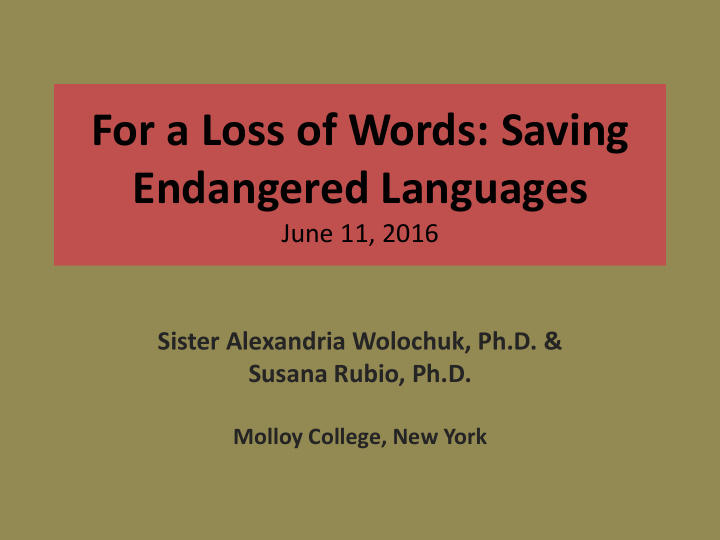



For a Loss of Words: Saving Endangered Languages June 11, 2016 Sister Alexandria Wolochuk, Ph.D. & Susana Rubio, Ph.D. Molloy College, New York
“Language is the most massive and inclusive art we know, a mountainous and unconscious work of anonymous generations.” Edward Sapir “Language is what makes society possible, by binding humans together into groups: village, tribe, ethos, nation. It serves as a token of ethnic identity and belonging, as visible and obvious as ritual scarring… In each culture, language lays the foundation for the world as they (or we) may know it. Without it, people are adrift, unaccounted for, unnamed.” David Harrison
The Order of Preachers and the indigenous languages
What is happening to language diversity? • One language dies every 14 days. • By the end of this century, nearly half of the estimated 7,000 languages now spoken worldwide could disappear, as the only people left speaking them are elderly adults. ]
Language Inequality
Where is it happening? “Dying languages succumb more discreetly. Village by village they go under - no shouting, no watery rukus. Just a simple, sudden absence. It takes a shrewd eye to spot these silent catastrophes, and a frugal, determined heart to intervene.” John Goulet
Why is it happening? Physical Factors • The physical safety of a population is compromised Political, Social and Economical Threats • Displacement • Civil strife • Represive and hegemoic language policies • Globalization • Industrialization • Cultural assimilation • Human induced climate change and environmental degradation
Kayapo Woman, Brazil. For decades now, the Kayapo people, and others of the Amazonian Region have been struggling with the avalanche of invasion to their lands from illegal logging, mining, cattle ranching and now the construction of the Belo Monte Dam. Photo, Cristina Mittermeier
Why does it matter? Languages have evolved built over time through people’s adaptation to the environment. Photo: Cristina Mittermeier
SERI [ hant iiha cöhacomxoj ] ones who have been told the ancient things She’s blind and nearly deaf, but Isabel Chavela Torres still passes on traditional knowledge. The Seri names for species in the Sonoran Desert and Gulf of California reveal behaviors scientists have only recently begun to discover. ( Mexico-Number of speakers 650-1,000)
TUVA [ songgaar ] [ burungaar ] go back = the future go forward = the past Tuvans believe the past is ahead of them while the future lies behind. The children who flock to this bungee-cord ride outside the National Museum of Tuva look to the future, but it’s behind them, not yet seen.
Language encodes a way of WINTU interpreting the world, thus (California) renders the identity of a “ This mountain has my heart.” community. Caleen Sisk is the spiritual • Time leader and the tribal chief of the Winnemem Wintu tribe — and a last speaker • Number/Count- of the language that sustains her people’s ing Systems identity. For a hundred years, the tribe has been • Colors fighting with the U.S. government over its territory along the • Space McCloud River, abutting Mount Shasta, which they consider their birthplace. Loss of land and loss of language are connected, says Sisk. “ This land is our church.”
SERI [ Miixöni quih zó hant ano tiij? ] Where is your placenta buried? This is how the Seris ask, “Where are you from ?” Those who were born before hospital births know the exact spot where their afterbirth was placed in the ground, covered in sand and ash, and topped with rocks.
What can be done? • Documentation • Maintenance • Preservation • Revitalization
Revitalization: Language Vitality Factors
Songe Nimasow and Khandu Degio rap in the endangered Aka language of Arunachal Pradesh, India. Recorded by Dr. K. David Harrison for Enduring Voices Project with National Geographic.
Even though it is the indigenous peoples and local communities the ones that are being affected the most, the extinction of biocultural diversity threatens us all.
Recommend
More recommend